Breast, Cervical, Colorectal, Lung, and Prostate Cancers - Early Detection Summary Table
Only one measure per topic is displayed in the summary table. A complete set of measures, where they exist, can be found by following the More Information link in the table below.
 |
green - headed in the right direction |
 |
red - headed in the wrong direction |
 |
black - stable or non-significant change (NSC) |
 |
purple - indeterminate |
 |
blue - Healthy People 2030 target |
| Measure Name | Breast Cancer Screening | Cervical Cancer Screening | Colorectal Cancer Screening | Lung Cancer Screening | Prostate Cancer Screening |
|---|---|---|---|---|---|
| Year Range | 1987-2021 | 1987-2021 | 2000-2021 | 2010-2015 | 2005-2021 |
| Measure |
The percentage of women aged 50 to 74 years who reported having had a mammogram within the past 2 years, by race/ethnicity, income, and education level. |
The percentage of women aged 21 to 65 years who were up-to-date with cervical cancer screening, by race/ethnicity, income, and education level. For 2013 and before, up-to-date was defined as having a Pap test within the past 3 years. For 2014-2018, up-to date is defined as having a Pap test within the past 3 years for all women aged 21 to 65 years, or having a Pap test, with or without an HPV test, in the past 5 years for women aged 30 to 65 years. |
Optical or visualization screening testsColonoscopy - A procedure where a doctor looks into the rectum and the entire colon using a flexible narrow tube to identify colorectal cancer or precancerous polyps. Used not only as a screening test, colonoscopies are also used as a diagnostic procedure to follow up after positive results from a fecal occult blood test (FOBT) or fecal immunochemical test (FIT), fecal DNA test, sigmoidoscopy, or CT colonography. The USPSTF suggests a screening colonoscopy once every 10 years. |
Percentage of adults at risk for lung cancer due to smoking, aged 55-80 years, who had a CT scan to check for lung cancer within the past year, by sex, race/ethnicity, income, education level, age, and smoking pack years. |
The percentage of men aged 55 to 69 years who reported having had a PSA test within the past year, by race/ethnicity, income, education level, and age. This provides information about the use of PSA testing in the population. |
| Recent Summary Trend | Stable | Falling | Rising | Non-Significant Change | Falling |
| Recent Summary Trend Year Range | 2019-2021 | 2019-2021 | 2018-2021 | 2010-2015 | 2019-2021 |
| Desired Direction | Rising | Rising | Rising | Rising | Rising |
| Summary Graph |
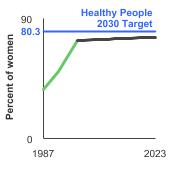
|
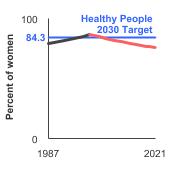
|
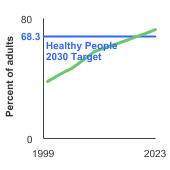
|
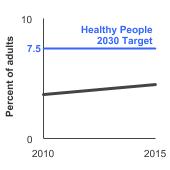
|
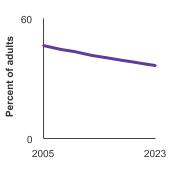
|
| Trends and Most Recent Estimates | In 2021, 75.9% of women aged 50-74 years had a mammogram within the past 2 years. | In 2021, 72.4% of women aged 21-65 were up-to-date with cervical cancer screening | In 2021, 71.8% of adults aged 50-75 had received a home FOBT in the last year or had a sigmoidoscopy in the past 5 years or had a colonoscopy in the past 10 years. | In 2015, 4.5% of adults aged 55-80 years who were at risk for lung cancer due to smoking had a CT scan to check for lung cancer within the past year. | In 2021, 37.1% of men aged 55-69 years had a PSA test within the past year. |
| Healthy People 2030 Target | Increase the proportion of women who receive a breast cancer screening based on the most recent guidelines to 80.5% | Increase the proportion of women who receive a cervical cancer screening based on the most recent guidelines to 84.3% | Increase the proportion of adults who receive a colorectal cancer screening based on the most recent guidelines to 74.4% |
Increase the proportion of adults who receive a lung cancer screening based on the most recent guidelines to 7.5% |
No Healthy People Target for this measure. |
| More Information | Breast Cancer Screening | Cervical Cancer Screening | Colorectal Cancer Screening | Lung Cancer Screening | Prostate Cancer Screening |
| Last Updated | March 2024 | March 2024 | March 2024 | March 2024 | March 2024 |
| Measure Name | Lung Cancer Screening |
|---|---|
| Year Range | 2010-2015 |
| Measure |
Percentage of adults at risk for lung cancer due to smoking, aged 55-80 years, who had a CT scan to check for lung cancer within the past year, by sex, race/ethnicity, income, education level, age, and smoking pack years. |
| Recent Summary Trend | Non-Significant Change |
| Recent Summary Trend Year Range | 2010-2015 |
| Desired Direction | Rising |
| Summary Graph |

|
| Trends and Most Recent Estimates | In 2015, 4.5% of adults aged 55-80 years who were at risk for lung cancer due to smoking had a CT scan to check for lung cancer within the past year. |
| Healthy People 2020 Target |
Increase the proportion of adults who receive a lung cancer screening based on the most recent guidelines to 7.5% |
| More Information | Lung Cancer Screening |
| Measure Name | Prostate Cancer Screening |
|---|---|
| Year Range | 2005-2021 |
| Measure |
The percentage of men aged 55 to 69 years who reported having had a PSA test within the past year, by race/ethnicity, income, education level, and age. This provides information about the use of PSA testing in the population. |
| Recent Summary Trend | Falling |
| Recent Summary Trend Year Range | 2019-2021 |
| Desired Direction | Rising |
| Summary Graph |

|
| Trends and Most Recent Estimates | In 2021, 37.1% of men aged 55-69 years had a PSA test within the past year. |
| Healthy People 2020 Target | No Healthy People Target for this measure. |
| More Information | Prostate Cancer Screening |
| Measure Name | Breast Cancer Screening |
|---|---|
| Year Range | 1987-2021 |
| Measure |
The percentage of women aged 50 to 74 years who reported having had a mammogram within the past 2 years, by race/ethnicity, income, and education level. |
| Recent Summary Trend | Stable |
| Recent Summary Trend Year Range | 2019-2021 |
| Desired Direction | Rising |
| Summary Graph |

|
| Trends and Most Recent Estimates | In 2021, 75.9% of women aged 50-74 years had a mammogram within the past 2 years. |
| Healthy People 2020 Target | Increase the proportion of women who receive a breast cancer screening based on the most recent guidelines to 80.5% |
| More Information | Breast Cancer Screening |
| Measure Name | Colorectal Cancer Screening |
|---|---|
| Year Range | 2000-2021 |
| Measure |
Optical or visualization screening testsColonoscopy - A procedure where a doctor looks into the rectum and the entire colon using a flexible narrow tube to identify colorectal cancer or precancerous polyps. Used not only as a screening test, colonoscopies are also used as a diagnostic procedure to follow up after positive results from a fecal occult blood test (FOBT) or fecal immunochemical test (FIT), fecal DNA test, sigmoidoscopy, or CT colonography. The USPSTF suggests a screening colonoscopy once every 10 years. |
| Recent Summary Trend | Rising |
| Recent Summary Trend Year Range | 2018-2021 |
| Desired Direction | Rising |
| Summary Graph |

|
| Trends and Most Recent Estimates | In 2021, 71.8% of adults aged 50-75 had received a home FOBT in the last year or had a sigmoidoscopy in the past 5 years or had a colonoscopy in the past 10 years. |
| Healthy People 2020 Target | Increase the proportion of adults who receive a colorectal cancer screening based on the most recent guidelines to 74.4% |
| More Information | Colorectal Cancer Screening |
| Measure Name | Cervical Cancer Screening |
|---|---|
| Year Range | 1987-2021 |
| Measure |
The percentage of women aged 21 to 65 years who were up-to-date with cervical cancer screening, by race/ethnicity, income, and education level. For 2013 and before, up-to-date was defined as having a Pap test within the past 3 years. For 2014-2018, up-to date is defined as having a Pap test within the past 3 years for all women aged 21 to 65 years, or having a Pap test, with or without an HPV test, in the past 5 years for women aged 30 to 65 years. |
| Recent Summary Trend | Falling |
| Recent Summary Trend Year Range | 2019-2021 |
| Desired Direction | Rising |
| Summary Graph |

|
| Trends and Most Recent Estimates | In 2021, 72.4% of women aged 21-65 were up-to-date with cervical cancer screening |
| Healthy People 2020 Target | Increase the proportion of women who receive a cervical cancer screening based on the most recent guidelines to 84.3% |
| More Information | Cervical Cancer Screening |